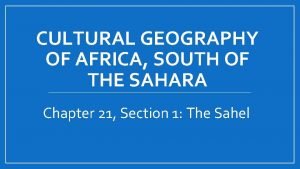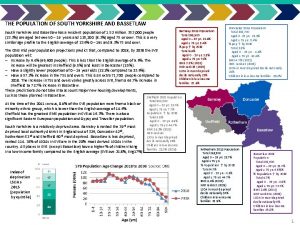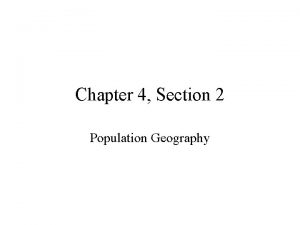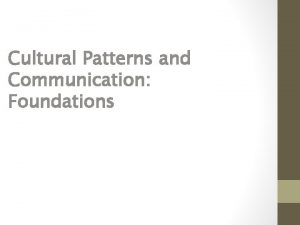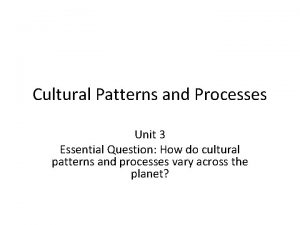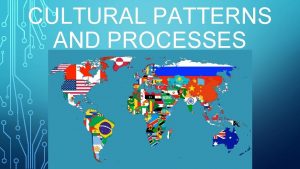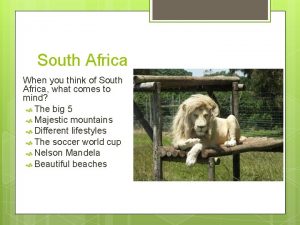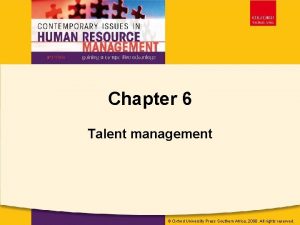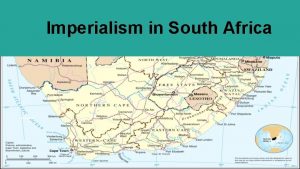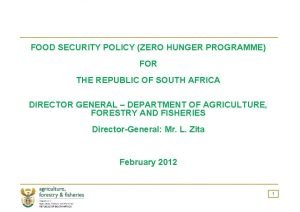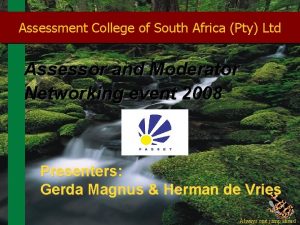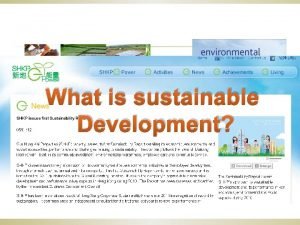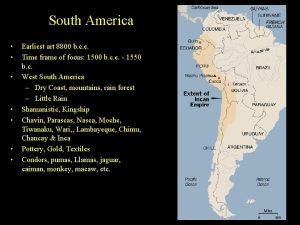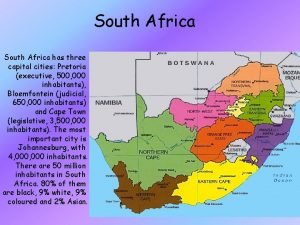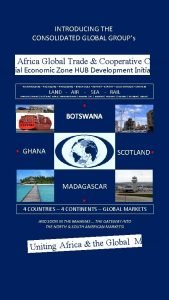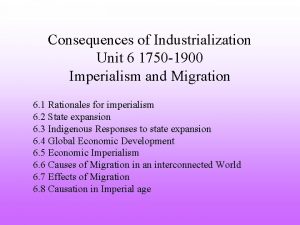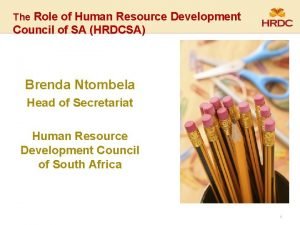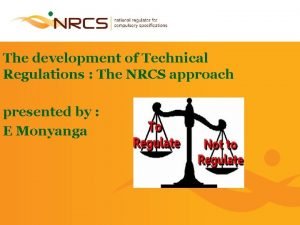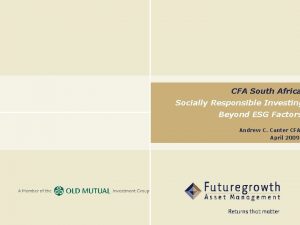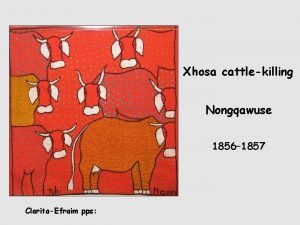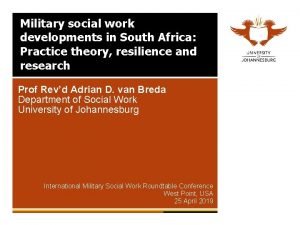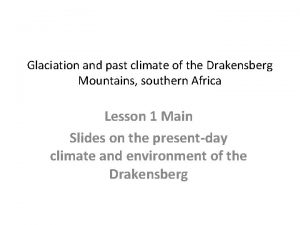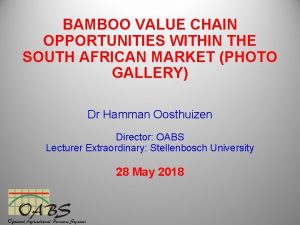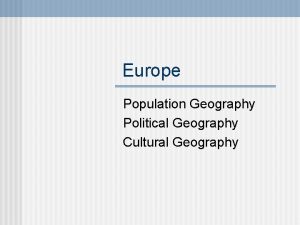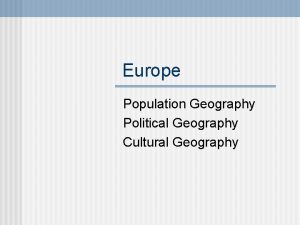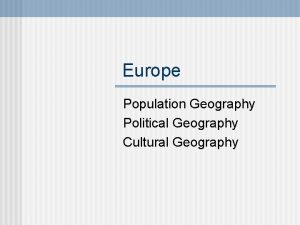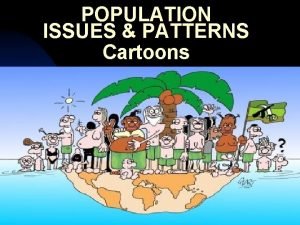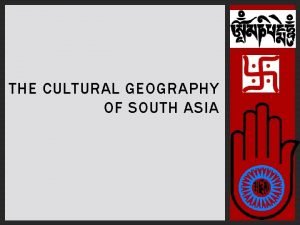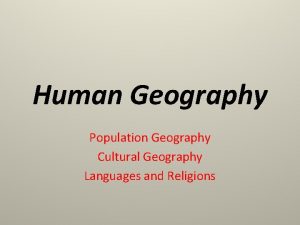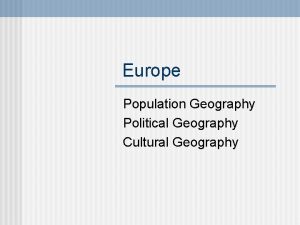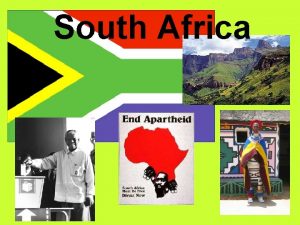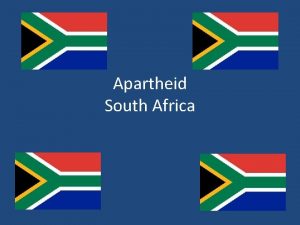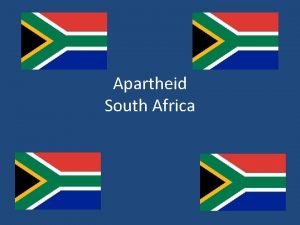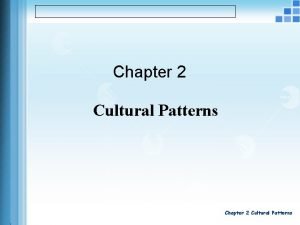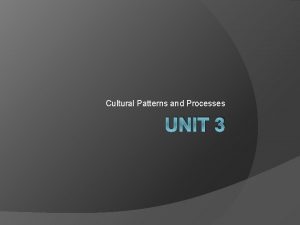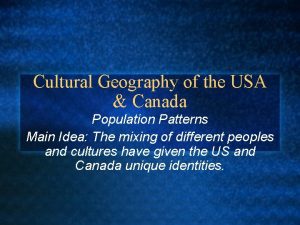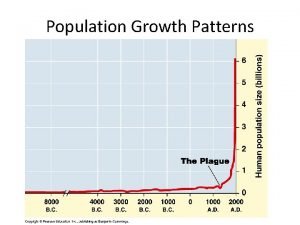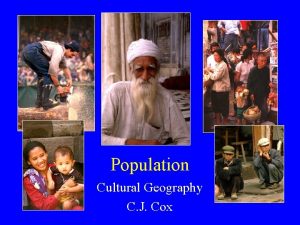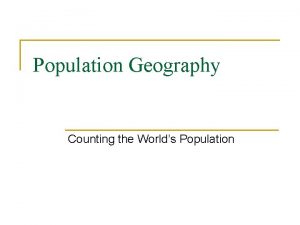Cultural Geography of Africa Population Patterns Africa south

















![Kingdom of Kush [295 BCE – 320 CE] Nubia [modern-day Sudan] Kingdom of Kush [295 BCE – 320 CE] Nubia [modern-day Sudan]](https://slidetodoc.com/presentation_image_h2/840618b3cbcb17690d9a598d83991fbf/image-18.jpg)



![Kingdom of Axum [300 -700] Kingdom of Axum [300 -700]](https://slidetodoc.com/presentation_image_h2/840618b3cbcb17690d9a598d83991fbf/image-22.jpg)







![Mansa Musa [r. 1312 -1337] http: //www. youtube. com/watch ? v=Ruh. VN 5 b Mansa Musa [r. 1312 -1337] http: //www. youtube. com/watch ? v=Ruh. VN 5 b](https://slidetodoc.com/presentation_image_h2/840618b3cbcb17690d9a598d83991fbf/image-30.jpg)






















![African Trade [15 c-17 c] African Trade [15 c-17 c]](https://slidetodoc.com/presentation_image_h2/840618b3cbcb17690d9a598d83991fbf/image-53.jpg)

















- Slides: 70

Cultural Geography of Africa •

Population Patterns • Africa south of the Sahara is home to 711 million people which makes up 11% of the worlds population. • It is also home to the highest birth rate and death rate in the world. • It has the world’s highest infant mortality rate and shortest life expectancy.

Early Man and Africa • The continent Africa was the birthplace of the hominin subfamily and the genus Homo, including eight species, of which only Homo sapiens survive. • Human culture in Africa is as old as the human race. • African history includes Neolithic (10, 000 BC) rock engravings, the glacial age petroglyphs (a carving or line drawing on rock, especially one made by prehistoric people) of early hunter-gatherers in the dry grasslands of North Africa, the Nomes of Egypt (3100 BC), and ancient Egypt. • http: //www. youtube. com/watch? v=r. MOtze. Jz. Pf 4

Early Man and Africa • Africa is one continent with several worlds. The continent of Africa covers an area of around 30 million square kilometers, one-fifth of the land mass of the Earth, and has more than 50 countries. • 800 million people of Africa have evolved a cultural milieu which is a study in contrast and have several dimensions. Africa was the birthplace of the human species between 8 million and 5 million years ago. • People across the continent are remarkably diverse by just about any measure: They speak a vast number of different languages, practice hundreds of distinct religions, live in a variety of types of dwellings, and engage in a wide range of economic activities. http: //www. youtube. com/watch? v=gf. RHLj. S_m. Bo

Early Man and Africa • Africa is home to innumerable tribes, ethnic and social groups, some representing very large populations consisting of millions of people, others are smaller groups of a few thousand. • Some countries have over 20 different ethnic groups. • All these tribes and groups have cultures which are different, but represent the mosaic of cultural diversity of Africa.

African Arts • African art constitutes one of the most diverse legacies on earth. • Though many casual observers tend to generalize "traditional" African art, the continent is full of peoples, societies, and civilizations, each with a unique visual special culture. • There are four main traits of African Art: Emphasis on the human figure, visual abstraction, emphasis on sculpture, emphasis on performance art.

Yoruba bronze head sculpture, Ife, Nigeria c. 12 th century A. D. •

Makonde carving c. 1974 •

African Languages • The continent of Africa speaks hundreds of languages and if dialects spoken by various ethnic groups are also included, the number is much higher. • All these languages and dialects do not have same importance: some are spoken by only few hundred persons, others are spoken by millions. • Among the most prominent languages spoken are Arabic, Swahili and Hausa.


African Languages • • • Four prominent language families of Africa are: Afro-Asiatic Nilo-Saharan Niger-Kordofanian Khoisan

African Food • Africa is a huge continent and the food and drink of Africa reflect local influences, as also glimpses of colonial food traditions, including use of food products like peppers, peanuts and maize introduced by the colonizers. • The African cuisine is a combination of traditional fruits and vegetables, milk and meat products. The African village diet is often milk, curds and whey. • Exotic game and fish are gathered from Africa's vast area.


Pre-Historic Africa


Ancient African Civilizations • Kush was a civilization centered in the region of Nubia, located in what is today northern Sudan. • One of the earliest civilizations to develop in the Nile River Valley, Kushite states rose to power before a period of Egyptian incursion into the area. • http: //www. youtube. com/watch? v=PTqj. Th. Zei 7 U • Nas^^ • People in Kush were called Kushites. • http: //www. youtube. com/watch? v=b 86 XE 3 Tb. Xg 0

Kushite in Egypt, 23 BCE
![Kingdom of Kush 295 BCE 320 CE Nubia modernday Sudan Kingdom of Kush [295 BCE – 320 CE] Nubia [modern-day Sudan]](https://slidetodoc.com/presentation_image_h2/840618b3cbcb17690d9a598d83991fbf/image-18.jpg)
Kingdom of Kush [295 BCE – 320 CE] Nubia [modern-day Sudan]

Pyramids of Kush at Meroë

Pyramids of Kush at Meroë

Ancient African Civilizations • The decline of the empire of Kush may have a few explanations. • 1. The Kingdom of Axum in Ethiopia attacked and ended the Kush empire. • 2. A visit from the Romans lead to a cultural makeover. • 3. The Romans recruited them to move to the lower Nile Delta to fill the power vaccum of a defeated people.
![Kingdom of Axum 300 700 Kingdom of Axum [300 -700]](https://slidetodoc.com/presentation_image_h2/840618b3cbcb17690d9a598d83991fbf/image-22.jpg)
Kingdom of Axum [300 -700]

Stele, Ezana’s Royal Tomb, Aksum (4 c)

Controlled NE African Trade AXUM’S ACHIEVEMENTS Written Language Built Stelae Terrace Farming Spread Christianity in No. & E. Africa

Ancient African Civilization • Timbuktu is a city in Tombouctou Region, in the West African nation of Mali. • It was merchants who set up the various markets and built permanent dwellings in the town, establishing the site as a meeting place for people traveling by camel. • Timbuktu grew to great wealth because of its key role in trans-Saharan trade in gold, ivory, slaves, salt and other goods by the Tuareg.

Timbuktu-”Heavenly Clay” https: //www. youtube. com/watc h? v=jvn. U 0 v 6 hc. Uo

Timbuktu Rooftop, Mosque

Tuaregs

Great Mosque at Djenne, Mali
![Mansa Musa r 1312 1337 http www youtube comwatch vRuh VN 5 b Mansa Musa [r. 1312 -1337] http: //www. youtube. com/watch ? v=Ruh. VN 5 b](https://slidetodoc.com/presentation_image_h2/840618b3cbcb17690d9a598d83991fbf/image-30.jpg)
Mansa Musa [r. 1312 -1337] http: //www. youtube. com/watch ? v=Ruh. VN 5 b 8 AFY&feature=rela ted


Engineering an Empire: Egypt • http: //www. youtube. com/watch? v=1 hlg. Diz mw. VM&list=PL 12 CB 6611766 FEDFF

An Egyptian Woman’s “Must. Haves” Mirror Perfume Whigs

Egyptian Social Hierarchy

Some Famous Egyptian Pharaohs Tutankhamon 1336 -1327 B. C. E. Thutmose III 1504 -1450 B. C. E. Ramses II 1279 -1212 B. C. E.

Papyrus Paper Hieratic Scroll Piece Papyrus Plant

Egyptian Math & Draftsmenship 1 10 1000 10, 000 100, 000 1, 000 What number is this?

Hieroglyphics = “Alphabet” 24 “letters” + 700 phonetic symbols

Champollion & the Rosetta Stone

The Rosetta Stone • The Rosetta Stone was helped translate Egyptian hieroglyphic writing. • Jean-François Champollion greatly expanded on this work and is credited as the principal translator of the Rosetta Stone. • Champollion could read both Greek and Coptic.

Stepped Pyramid at Saqqara

“Bent” Pyramid of King Sneferu

Giza Pyramid Complex http: //www. history. com/top ics/ancient-history/ancientegypt/videos

Archaeologist, Howard Carter (1922) http: //video. nationalgeographic. com/ video/player/places/countriesplaces/egypt/king-tuts-tomb. html

King Tutankhamon’s Death Mask 1336 -1327 B. C. E.

King Tutankhamon

King Tutankhamun’s Tomb

European Colonization • In the late nineteenth century, the European imperial powers engaged in a major territorial scramble and occupied most of the continent, creating many colonial nation states. • This time period is more commonly known as the “Scramble for Africa”.

Write down 3 Source for Raw Materials Industrial Revolution Markets for Finished Goods European Nationalism Missionary Activity European Motives For Colonization Military & Naval Bases Social Darwinism Places to Dump Unwanted/ Excess Popul. European Racism “White Man’s Burden” Humanitarian Reasons Soc. & Eco. Opportunities


European Colonization • Colonialism had a destabilizing effect on a number of ethnic groups that is still being felt in African politics. • Before European influence, national borders were not much of a concern, with Africans generally following the practice of other areas of the world, such as the Arabian Peninsula, where a group's territory was congruent with its military or trade influence.

European Colonization • The European insistence of drawing borders around territories to isolate them from those of other colonial powers often had the effect of separating otherwise contiguous political groups, or forcing traditional enemies to live side by side with no buffer between them. • For example, although the Congo River appears to be a natural geographic boundary, there were groups that otherwise shared a language, culture or other similarity living on both sides. • The division of the land between Belgium and France along the river isolated these groups from each other.
![African Trade 15 c17 c African Trade [15 c-17 c]](https://slidetodoc.com/presentation_image_h2/840618b3cbcb17690d9a598d83991fbf/image-53.jpg)
African Trade [15 c-17 c]

Post-Colonial Africa • Today, Africa contains 53 independent and sovereign countries, most of which still have the borders drawn during the era of European colonialism. • Since colonialism, African states have frequently been hampered by instability, corruption, violence, and authoritarianism. • The vast majority of African nations are republics that operate under some form of the presidential system of rule.

Political Challenges • 1950 s– 1960 s, many former European colonies ruled by dictators • Some nations fell into civil war • 1990 s brought renewed hope with the return of democracy; end of the apartheid system in South Africa Protesting Apartheid • Early 1900 s, African National Congress formed in South Africa • ANC petitioned government, held peaceful protests against apartheid • 1940 s, younger, radical members joined, including Nelson Mandela Change of Philosophy • 1952, Mandela organized campaign urging blacks in South Africa to break apartheid laws • 1960, changed from peaceful philosophy after police killed demonstrators in Sharpeville The Sharpeville Massacre was a turning point in the anti-apartheid movement.

Democracy in South Africa • 1990, President F. W. de Klerk legalized ANC, began negotiations to enact new constitution, end apartheid – Released Mandela from prison – Lifted long-standing ban on African National Congress • De Klerk also abolished homelands, held South Africa’s first democratic elections – ANC swept elections – Mandela became first black president of a democratic South Africa

Military Dictatorships One–Party System • End of 1960 s, nearly all newly independent African nations adopted one-party system • Single political party controls government – Elections rarely competitive – Opposition parties outlawed in many countries • Dictators ruled many nations, maintained power through patronage, giving loyal followers well-paid positions in government Bribery and Corruption • Some corrupt officials required bribes for government contracts, licenses • Also ran government enterprises for personal profit • New generation of dictators robbed countries of wealth – Mobutu Sese Seko, dictator of Congo, amassed personal fortune of about $5 billion, while his people fell into poverty

Ethnic Conflicts and Civil War When the European powers divided Africa into colonies, preexisting political units were not maintained. Ethnic Conflicts • After independence, rival ethnic groups competed for control, some by destructive civil wars Civil Wars • 1992, civil war, drought led to suffering in Somalia • 1967, Igbo-speaking group of eastern Nigeria proclaimed independent state of Biafra • Hundreds of thousands of Somalis died when warring militias stole food sent from international relief agencies • Bloody civil war erupted; 2 million died from fighting, another 2 million from starvation • 1990 s, tensions between Hutu, Tutsi erupted in violence in Rwanda. • 1994, 1 million Tutsi, moderate Hutus massacred in Hutu-led government genocide

Economic and Environmental Challenges After achieving independence, many African nations faced economic challenges that came with their new status. In addition, Africans had to combat the spread of disease and environmental problems. Struggling Economies Farming, Mining Development Loans • After independence most African nations’ economies fragile • African nations not industrialized, depended on farming, mining raw materials • For loans, turned to international organizations, like World Bank; bad planning, corrupt leaders left nations with huge debts, no infrastructure • Depended on only one, two exports for support • Example: Ghana depended on cocoa; Nigeria, oil

Disease • African nations also challenged by management of deadly diseases • Malaria continues to be one of most common causes of death today • 1980 s, new disease, acquired immune deficiency syndrome (AIDS) spread rapidly throughout Africa AIDS • HIV virus that causes AIDS weakens body’s immune system, results in death • Social costs in sub-Saharan Africa staggering; millions of orphaned children because parents died from AIDS • Only small percentage of infected Africans receiving AIDS treatment

AIDS in Africa • Although it is not correct to speak of a single African epidemic, Africa is without doubt the region most affected by the virus. • Inhabited by just over 12% of the world's population, Africa is estimated to have more than 60% of the AIDS-infected population. • http: //www. youtube. com/watch? v=mog. Twwepces • In the 35 African nations with the highest prevalence, average life expectancy is 48. 3 years— 6. 5 years less than it would be without the disease

AIDS in Africa • In Southern Africa, several factors contribute to the spread of the HIV virus. For one, a stigma is attached to admitting to HIV infection and to using condoms. • For another, many deny that the HIV virus causes AIDS: Thabo Mbeki and Robert Mugabe have both suggested AIDS stems from poverty rather than HIV infection. • And finally, many myths attach to the use of condoms, such as the ideas that a conspiracy wants to limit the growth of the African population and that condoms stifle the traditional power of the man in his community.

Infection Rates of HIV/AIDS •

Economy of Africa • Although it has abundant natural resources, Africa remains the world's poorest and most underdeveloped continent. • This is due largely to the effects of the slave trade, corrupt governments, failed central planning, the international trade regime and geopolitics; as well as widespread human rights violations, the negative effects of colonialism, despotism, illiteracy, superstition, tribal savagery and conflict

Economy of Africa • Widespread poverty, illiteracy, malnutrition and inadequate water supply and sanitation, as well as poor health, affect a large majority of the people who reside in the African continent, where 36. 2% of the population is living on under $1 per day. • Africa is by far the world's poorest inhabited continent, and on average, in 2003 it was poorer than it was in 1973.

“Blood Diamonds” & Africa • In relation to diamond trading, blood diamond refers to a diamond mined in a war zone and sold to finance an insurgency, invading army's war efforts, or a warlord's activity. • Reports estimated that as much as 20% of total production in the 1990 s were being sold for illegal purposes, and 15% were specifically conflict in nature. • http: //www. snagfilms. com/films/title/blood_diamon ds_diamonds_of_war

“Blood Diamonds” & Africa • Cecil John Rhodes, (5 July 1853 – 26 March 1902) was an English-born businessman, mining magnate, and politician in South Africa. • He was the founder of the diamond company De Beers, which today markets 40% of the world's rough diamonds and at one time marketed 90%.

Cecil Rhodes • He was an ardent believer in colonialism and was the founder of the state of Rhodesia, which was named after him. Rhodesia, later Northern and Southern Rhodesia, eventually became Zambia and Zimbabwe respectively. • South Africa's Rhodes University is named in tribute to him, and he is also known for the Rhodes Scholarship which is funded by his estate.

Apartheid in South Africa • Apartheid was a system of legal racial segregation enforced by the National Party government of South Africa between 1948 and 1990. • Apartheid legislation classified inhabitants and visitors into racial groups (black, white, colored, and Indian or Asian). • The government segregated education, medical care, and other public services, and provided black people with services greatly inferior to those of whites, and, to a lesser extent, to those of Indians and coloreds.

Apartheid in South Africa • The education system practiced in 'black schools' was designed to prepare blacks for lives as a laboring class.
 Reteaching activity 24 cultural geography of south asia
Reteaching activity 24 cultural geography of south asia Cultural geography of africa
Cultural geography of africa Chapter 4 section 1 population dynamics
Chapter 4 section 1 population dynamics Population ecology section 1 population dynamics
Population ecology section 1 population dynamics Population ecology section 1 population dynamics
Population ecology section 1 population dynamics Population ecology section 1 population dynamics
Population ecology section 1 population dynamics Population of bassetlaw
Population of bassetlaw Old south vs new south streetcar named desire
Old south vs new south streetcar named desire Chapter 4 section 2 population geography
Chapter 4 section 2 population geography Baby boom definition ap human geography
Baby boom definition ap human geography Cultural taxonomies
Cultural taxonomies What is cultural patterns
What is cultural patterns Cultural patterns and processes
Cultural patterns and processes Taxonomies of cultural patterns are
Taxonomies of cultural patterns are Obj dating
Obj dating Associations and correlations in data mining
Associations and correlations in data mining Agrement south africa
Agrement south africa Herbalife levels and income
Herbalife levels and income Causes of unemployment in south africa
Causes of unemployment in south africa Dr hamilton
Dr hamilton Doctrine of unjust enrichment
Doctrine of unjust enrichment Southwest asia and north africa map
Southwest asia and north africa map 11 official languages of south africa
11 official languages of south africa Was south africa a dutch colony
Was south africa a dutch colony How many capital cities in south africa
How many capital cities in south africa Anc card
Anc card Oxford university press south africa
Oxford university press south africa National core standards in nursing
National core standards in nursing South african national archives
South african national archives Safbc
Safbc Imperialism in africa timeline
Imperialism in africa timeline Zero hunger programme south africa
Zero hunger programme south africa Neuropsychology in south africa
Neuropsychology in south africa Coastal region south africa
Coastal region south africa Banc plus 2019
Banc plus 2019 Assessment college of sa (pty) ltd
Assessment college of sa (pty) ltd Did the dutch colonize south africa
Did the dutch colonize south africa When did the dutch colonize south africa
When did the dutch colonize south africa Rx24 pills price
Rx24 pills price Rx24 pills
Rx24 pills 2020 revised curriculum and assessment plans
2020 revised curriculum and assessment plans North america south america asia europe africa
North america south america asia europe africa Bibliography of drought in south africa
Bibliography of drought in south africa Stanton chase
Stanton chase Oculate south africa
Oculate south africa Three capital cities of south africa
Three capital cities of south africa Apartheid south africa
Apartheid south africa Grant hatlen south africa
Grant hatlen south africa Bringing ivory to the wagons in south africa
Bringing ivory to the wagons in south africa Open-shaft diamond mining at kimberley south africa in 1872
Open-shaft diamond mining at kimberley south africa in 1872 Historical development of community work
Historical development of community work Conclusion for training and development ppt
Conclusion for training and development ppt Nrcs south africa
Nrcs south africa South african furniture initiative
South african furniture initiative Community education and training colleges
Community education and training colleges Cfa south africa
Cfa south africa Blue deal south africa
Blue deal south africa Exhibition stand cape town
Exhibition stand cape town Ameu south africa
Ameu south africa Who was nongqawuse
Who was nongqawuse Animal stak bodybuilding
Animal stak bodybuilding Squash rules south africa
Squash rules south africa Susan keane south africa
Susan keane south africa Military social work in south africa
Military social work in south africa State of emergency declared south africa
State of emergency declared south africa South africa climate graph
South africa climate graph Product labelling requirements south africa
Product labelling requirements south africa Eeo principles australia
Eeo principles australia Daniel adams pretoria
Daniel adams pretoria Tsplus software name
Tsplus software name Bamboo globalization south africa
Bamboo globalization south africa

